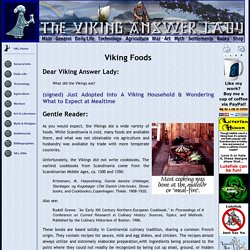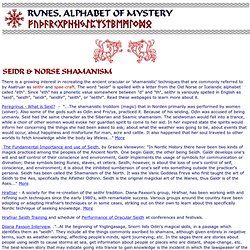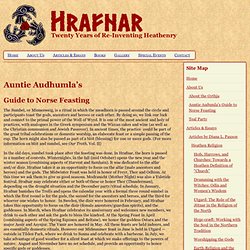

Shamanism: Scandinavian Center for Shamanic Studies. Viking Foods. Dear Viking Answer Lady: What did the Vikings eat?

(signed) Just Adopted into A Viking Household & Wondering What to Expect at Mealtime Gentle Reader: As you would expect, the Vikings ate a wide variety of foods. While Scandinavia is cold, many foods are available there, and what was not obtainable via agriculture and husbandry was available by trade with more temperate countries. Unfortunately, the Vikings did not write cookbooks. Kristensen, M. Also see: Rudolf Grewe. These books are based solidly in Continental culinary tradition, sharing a common French origin. Another post-Viking Age Scandinavian source would be a list of meals served during the course of a year to the Swedish bishop Hans Brask around 1520: Hildebrand, H., ed. More information may be determined through archaeological investigation. Skallagrim was also a great shipwright. While these sources may tell us what foods were eaten, they do not tell us how they were prepared.
General Information Daily Meals Types of Food Protein. Hrafnar. Seidr & Norse Shamanism-Trance Travel & Magic. There is a growing interest in recreating the ancient oracular or 'shamanistic' techniques that are commonly referred to by Asatruar as seithr and spae-craft.

The word "seidr" is spelled with a letter from the Old Norse or Icelandic alphabet called "eth". Since "eth" has a phonetic value somewhere between "d" and "th", seithr is variously spelled in English as "seid", "seidh", "seidr", "seidhr", "seith", or "seithr". Read these webpages to learn more about it. Peregrinus - What is Seid? - "...The shamanistic trolldom (magic) that in Norden primarily was performed by women (volver). The Fundamental Importance and use of Seidh, by Graena Vanswynn: "In Nordic History there have been two kinds of magick practiced among the peoples of the Ancient North.
Hrafnar - A society for the re-creation of the seithr tradition. Hrafnar Seidh Training and schedule of Performance of Oracular Seidh at conferences and festivals. Sex, Status, and Seidh: Homosexuality and Germanic Religion, by Diana L. Feast. The Sumbel, or Minnesweig, is a ritual in which the meadhorn is passed around the circle and participants toast the gods, ancestors and heroes or each other.

By doing so, we link our luck and connect to the primal power of the Well of Wyrd. It is one of the most ancient and holy of practices, with analogues in the Greek symposium and the Wiccan cakes and wine (as well as the Christian communion and Jewish Passover). In ancient times, the practice could be part of the great tribal celebrations or domestic worship, an elaborate feast or a simple passing of the cup. The horn might also be passed as part of a blót (blessing) for one or more gods. (For more information on blót and sumbel, see Our Troth, Vol. In the old days, sumbel took place after the feasting was done. In a traditional setting, folk journeyed for days to get to the steading where the feast would be held and stayed a week or more. The invocations are serious, but not solemn. The beverage used depends on the deity. Skaal!